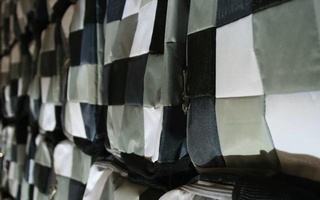It is not often that one can experience an art museum during the walk to Lamont Library or biology lab. However, this spring, the Harvard Graduate School of Design (GSD) and the Harvard Art Museums have joined in a collaborative effort to produce “a project in art and the public domain” entitled “The Divine Comedy.” A trio of innovative installations, “The Divine Comedy” is not placed inside Harvard’s traditional gallery spaces, but are—for the most part—outside and highly visible. Attracting the eyes of passersby, a looming inflatable form rises above the walkway of the Carpenter Center for the Visual Arts and enormous cubes of gray-tiled backpacks linger near the entrance of Northwest Labs.
And visibility is the goal. “The point [of “The Divine Comedy”] is to change how people conceive of the yard, to transform people’s conceptions of art,” said Dan F. Borelli, Director of Exhibitions at the GSD. He emphasizes the openness of the installations, which are located in the GSD’s Gund Hall, on the terrace of the Carpenter Center, and outside of Northwest Labs. “The project is about art in the public domain. Each of the three sites is publicly accessible. There’s no admission. There’s an open-door policy,” Borelli said.
This artistic “open-door policy” is uncommon for the Harvard Art Museums. “Compared to [Massachusetts Institute of Technology], Harvard has a little bit of a void when it comes to public art ... there isn’t a public art curator,” said Suelin Chen, Director of the Laboratory at Harvard, “so it’s really great for Harvard to have these types of projects happen.”
The installation placed on the terrace of the Carpenter Center is Tomás Saraceno’s “Cloud City,” which explores our relationship to the cosmos. The installation, as curator Sanford Kwinter wrote on “The Divine Comedy” website, is an “air-filled, seven-meter-tall, 14-sided, irregular, transparent structure loaded with solar cells, sensors, recorders, and transmitters intended not only to record the environment but to incorporate and be integrated into it as well.” Olafur Eliasson’s “Three to Now,” located in Gund Hall, looks inward and deals with differences in individual perception. As Kwinter describes, “Perceiver and perceived are indissociable—to alter one, without exception, is to alter the other.” However, perhaps the most visible work of them all is that of Chinese activist and artist Ai Weiwei, whose installation “Untitled” is placed on the lawn in front of Northwest Labs.
The story of Weiwei’s “Untitled” is still in progress. Famed as the artistic consultant for design of the “Bird’s Nest,” the Beijing National Stadium for the 2008 Summer Olympics—and renowned later for his combative stance towards the oppressive Chinese government during the games—Weiwei was captured and placed under arrest on April 3. His release, like the fates of his family and collaboraters, remains uncertain.
“Untitled,” is concerned with yet another facet of Weiwei’s political activism. The installation, Kwinter wrote, makes public the findings of a year-long “‘Citizens’ Investigation’ of the May 2008 Sichuan Province earthquake ... on behalf of the thousands of student victims of the disaster.” Thousands of schoolchildren, many whose names are still unknown, were killed in the disaster. “After the earthquake, the government didn’t release the names of the victims, so [Ai Weiwei] used the Internet to gather those names,” Chen said.
In the “Citizen’s Investigation,” Ai Weiwei initiated a survey of 150 schools in 74 towns to recover the names, birth dates, and the names of the schools of the children who were killed. The project was not looked kindly upon by the national government. “The investigation uncovered the subsequently widely reported fact that the defective ‘tofu construction’ of school buildings played a principal role in the disproportionately high mortality rate of schoolchildren, a fact that was strenuously covered up by government authorities,” Kwinter wrote.
Each child recorded by Weiwei’s investigation is commemorated by one of the 5,335 backpacks on display in “Untitled.” “It makes a huge aesthetic impact as you walk up to the building ... you can walk through it, around it, and just the scale of it ... it’s monumental,” Chen said.
Beyond just the aesthetic impact, though, this is a piece of art imbued explicitly with a sense of activism. “From what I’ve read of Ai Weiwei, he felt a responsibility to talk about [what the government covered up] in a vacuum where some people felt that they couldn’t. It’s being a responsible citizen,” Borelli said.
While Ai Weiwei remains hidden away in prison, his art—and the work of his contemporaries in “The Divine Comedy”—is in plain view, presented for all to see and to remember.
Read more in Arts
Preview: The StoryRecommended Articles
-
 Chinese Artist Responsible for NW Labs Installation Detained
Chinese Artist Responsible for NW Labs Installation Detained -
Notes on Ai WeiweiIt was when he moved back to China to be with his ailing father that Ai grew interested in the social landscape of his country, and began to ask how one could utilize modern design techniques to highlight political issues.
-
From Terrorism to the Spectacle of TerrorPerhaps nothing provokes such instantaneous spectacle as surely as terrorism
-
Taking on the AINot everything about the Academic Index is as clear-cut as how it is calculated.
-
 Admissions Expert Anna Ivey Gives Advice on Early Action and Early Decision
Admissions Expert Anna Ivey Gives Advice on Early Action and Early Decision -
An Introduction to the Academic IndexWith varsity recruiting season in full swing, high school athletes across the country are committing to play for their dream schools. But for athletes being recruited to the Ivy League the process is slightly different.














